
Cosmic microwave background experiments
Encyclopedia

Experiment
An experiment is a methodical procedure carried out with the goal of verifying, falsifying, or establishing the validity of a hypothesis. Experiments vary greatly in their goal and scale, but always rely on repeatable procedure and logical analysis of the results...
s to measure the Cosmic microwave background (CMB) radiation
Cosmic microwave background radiation
In cosmology, cosmic microwave background radiation is thermal radiation filling the observable universe almost uniformly....
anisotropies and polarization since its first observation in 1964 by Penzias
Arno Allan Penzias
Arno Allan Penzias is an American physicist and Nobel laureate in physics.-Early life and education:Penzias was born in Munich, Germany. At age six he was among the Jewish children evacuated to Britain as part of the Kindertransport rescue operation...
and Wilson
Robert Woodrow Wilson
For the American President, see Woodrow Wilson.Robert Woodrow Wilson is an American astronomer, 1978 Nobel laureate in physics, who with Arno Allan Penzias discovered in 1964 the cosmic microwave background radiation...
. These include a mix of ground-, balloon- and space-based receivers. The most notable of these are COBE
COBE
The COsmic Background Explorer , also referred to as Explorer 66, was a satellite dedicated to cosmology. Its goals were to investigate the cosmic microwave background radiation of the universe and provide measurements that would help shape our understanding of the cosmos.This work provided...
, which first detected the temperature anisotropies of the CMB, and showed that it had a black body spectrum; DASI
Dasi
-Mainland China:* Dasi, Qinzhou , town in Qinbei District, Qinzhou, Guangxi* Dasi, Taizhou, Jiangsu , town in Gaogang District, Taizhou, Jiangsu* Dasi, Tianjin , town in Xiqing District, Tianjin...
, which first detected the polarization signal from the CMB; CBI
Cosmic Background Imager
The Cosmic Background Imager was a 13-element interferometer perched at an elevation of 5,080 metres at Llano de Chajnantor Observatory in the Chilean Andes...
that made high-resolution observations and obtained the first E-mode polarization spectrum and WMAP, which has provided the best full-sky CMB maps to date. Planned future experiments include the Planck spacecraft, which aims to produce high-resolution all-sky maps of both the temperature anisotropies and polarization signals, and various ground-based experiments primarily intended to investigate small-scale anisotropies and trying to detect the polarization caused by gravitational wave
Gravitational wave
In physics, gravitational waves are theoretical ripples in the curvature of spacetime which propagates as a wave, traveling outward from the source. Predicted to exist by Albert Einstein in 1916 on the basis of his theory of general relativity, gravitational waves theoretically transport energy as...
s in the early universe
Universe
The Universe is commonly defined as the totality of everything that exists, including all matter and energy, the planets, stars, galaxies, and the contents of intergalactic space. Definitions and usage vary and similar terms include the cosmos, the world and nature...
.
The design of cosmic microwave background experiments is a very challenging task. The greatest problems are the receivers, the telescope optics and the atmosphere. Many improved microwave amplifier technologies have been designed for microwave background applications. Some technologies used are HEMT
HEMT
High electron mobility transistor , also known as heterostructure FET or modulation-doped FET , is a field effect transistor incorporating a junction between two materials with different band gaps as the channel instead of a doped region, as is generally the case for MOSFET...
, MMIC
Monolithic Microwave Integrated Circuit
A Monolithic Microwave Integrated Circuit, or MMIC , is a type of integrated circuit device that operates at microwave frequencies . These devices typically perform functions such as microwave mixing, power amplification, low noise amplification, and high frequency switching...
, SIS
Superconductor-Insulator-Superconductor
The superconducting tunnel junction — also known as a superconductor–insulator–superconductor tunnel junction — is an electronic device consisting of two superconductors separated by a very thin layer of insulating material. Current passes through the junction via the process of quantum...
and bolometer
Bolometer
A bolometer is a device for measuring the power of incident electromagnetic radiation via the heating of a material with a temperature-dependent electrical resistance. It was invented in 1878 by the American astronomer Samuel Pierpont Langley...
s. Experiments generally use elaborate cryogenic
Cryogenics
In physics, cryogenics is the study of the production of very low temperature and the behavior of materials at those temperatures. A person who studies elements under extremely cold temperature is called a cryogenicist. Rather than the relative temperature scales of Celsius and Fahrenheit,...
systems to keep the amplifiers cool. Often, experiments are interferometers which only measure the spatial fluctuations in signals on the sky, and are insensitive to the average 2.7 K background.
Another problem is the 1/f noise intrinsic to all detectors. Usually the experimental scan strategy is designed to minimize the effect of such noise. To minimize side lobe
Side lobe
In antenna engineering, side lobes or sidelobes are the lobes of the far field radiation pattern that are not the main lobe....
s, microwave optics usually utilize elaborate lenses
Lens (optics)
A lens is an optical device with perfect or approximate axial symmetry which transmits and refracts light, converging or diverging the beam. A simple lens consists of a single optical element...
and feed horn
Feed horn
In satellite dish and antenna design, a feedhorn is a small horn antenna used to convey radio waves between the transmitter and/or receiver and the reflector, particularly in parabolic antennas...
s. Finally, the atmosphere is an issue because water absorbs microwave radiation (a fact utilized in the operation of microwave oven
Microwave oven
A microwave oven is a kitchen appliance that heats food by dielectric heating, using microwave radiation to heat polarized molecules within the food...
s), it is rather difficult to observe the microwave background with ground-based instruments. CMB research therefore makes increasing use of air and space-borne experiments. Ground-based observations are usually made from dry, high altitude locations such as the Chilean Andes
Andes
The Andes is the world's longest continental mountain range. It is a continual range of highlands along the western coast of South America. This range is about long, about to wide , and of an average height of about .Along its length, the Andes is split into several ranges, which are separated...
and the South Pole
South Pole
The South Pole, also known as the Geographic South Pole or Terrestrial South Pole, is one of the two points where the Earth's axis of rotation intersects its surface. It is the southernmost point on the surface of the Earth and lies on the opposite side of the Earth from the North Pole...
.
The list below consists of a partial list of past, current and planned CMB experiments. The name, start and end years of each experiment are given, followed by the basis of the experiment—whether space, balloon or ground based—and the location where appropriate. The frequency and amplifier technologies used are given, as is the main targets of the experiments.
| Image | Name | Start | End | Basis | Location | Frequency (GHz) | Amplifier technology | Targets | Ref(s) |
|---|---|---|---|---|---|---|---|---|---|
| Advanced Cosmic Microwave Explorer (ACME) Also HACME: HEMT HEMT High electron mobility transistor , also known as heterostructure FET or modulation-doped FET , is a field effect transistor incorporating a junction between two materials with different band gaps as the channel instead of a doped region, as is generally the case for MOSFET... +ACME |
1988 | 1996 | Ground | 26–35; 38–45 | HEMT | Temperature anisotropies | |||
| Antarctic Plateau Anisotropy Chasing Experiment (APACHE) | 1995 | 1996 | Ground | Antarctic Antarctic The Antarctic is the region around the Earth's South Pole, opposite the Arctic region around the North Pole. The Antarctic comprises the continent of Antarctica and the ice shelves, waters and island territories in the Southern Ocean situated south of the Antarctic Convergence... |
100, 150, 250 | Bolometer | Temperature anisotropies | ||
| Absolute Radiometer for Cosmology, Astrophysics, and Diffuse Emission Absolute Radiometer for Cosmology, Astrophysics, and Diffuse Emission Absolute Radiometer for Cosmology, Astrophysics, and Diffuse Emission is a program which utilizes balloon satellite instrument package intended to measure the heating of the universe by the first stars and galaxies after the big bang and search for the signal of relic decay or annilhilation... (ARCADE) |
2001 | — | Balloon | 3, 5, 7, 10, 30, 90 | HEMT | CMB Spectrum | |||
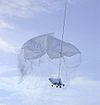 |
Archeops Archeops Archeops was a balloon-borne instrument dedicated to measuring the Cosmic microwave background temperature anisotropies. The study of this radiation is essential to obtain precise information on the evolution of the Universe: density, Hubble constant, age of the Universe, etc... |
1999 | 2002 | Balloon | 143, 217, 353, 545 | Bolometer | Measured large and intermediate scale with improved precision at the larger scales. | ||
| Arcminute Cosmology Bolometer Array Receiver Arcminute Cosmology Bolometer Array Receiver ACBAR is an experiment to measure the anisotropy of the Cosmic microwave background.The ACBAR 145 GHz measurements are the most precise high multipole measurements of the CMB to date.-External links:**... (ACBAR) |
2001 | — | Ground | 150, 219, 274 | Bolometer | Temperature anisotropies | |||
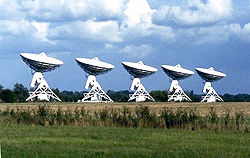 |
Arcminute Microkelvin Imager Arcminute Microkelvin Imager The Arcminute Microkelvin Imager consists of a pair of interferometric radio telescopes - the Small and Large Arrays - located at the Mullard Radio Astronomy Observatory near Cambridge. AMI was designed, built and is operated by the Cavendish Astrophysics Group... (AMI) |
2005 | — | Ground | UK: Mullard Radio Astronomy Observatory Mullard Radio Astronomy Observatory Mullard Radio Astronomy Observatory is home to a number of large aperture synthesis radio telescopes, including the One-Mile Telescope, 5-km Ryle Telescope, and the Arcminute Microkelvin Imager... |
12-18 | Interferometer | SZ effect, Temperature anisotropies | |
| ARGO ARGO ARGO is a manufacturer of amphibious all-terrain vehicles. It was founded in 1962 as Ontario Drive and Gear Limited, in Kitchener, Ontario and was later moved to New Hamburg, Ontario. ARGO offers 6x6 & 8x8 amphibious vehicles.-History:... |
1988, 1990, 1993 | 1993 | Balloon | 150-600 | Bolometer | ||||
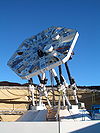 |
Array for Microwave Background Anisotropy (AMiBA) | 2002 | — | Ground | Hawaii: Mauna Loa Mauna Loa Mauna Loa is one of five volcanoes that form the Island of Hawaii in the U.S. state of Hawaii in the Pacific Ocean, and the largest on Earth in terms of volume and area covered. It is an active shield volcano, with a volume estimated at approximately , although its peak is about lower than that... |
86-102 | MMIC | SZ effect; Polarization | |
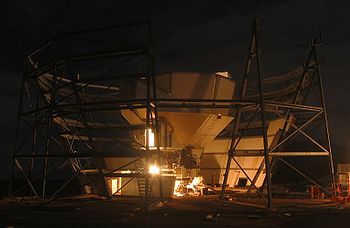 |
Atacama Cosmology Telescope Atacama Cosmology Telescope The Atacama Cosmology Telescope is a six-metre telescope on Cerro Toco in the Atacama Desert in the north of Chile, near the Llano de Chajnantor Observatory. It is designed to make high-resolution, microwave-wavelength surveys of the sky in order to study the cosmic microwave background radiation... (ACT) |
2007 | — | Ground | Chile Chile Chile ,officially the Republic of Chile , is a country in South America occupying a long, narrow coastal strip between the Andes mountains to the east and the Pacific Ocean to the west. It borders Peru to the north, Bolivia to the northeast, Argentina to the east, and the Drake Passage in the far... : Atacama Desert Atacama Desert The Atacama Desert is a plateau in South America, covering a strip of land on the Pacific coast, west of the Andes mountains. It is, according to NASA, National Geographic and many other publications, the driest desert in the world... |
145, 225, 265 | Bolometer | Temperature anisotropies | |
 |
Atacama Pathfinder Experiment Atacama Pathfinder Experiment The Atacama Pathfinder Experiment is a radio telescope located at 5,100 meters above sea level, at the Llano de Chajnantor Observatory in the Atacama desert, in northern Chile, 50 kilometers to the east of San Pedro de Atacama. The main dish has a diameter of 12 meters and consists of 264... (APEX) |
2005 | — | Ground | 150, 217 | Bolometer | Temperature anisotropies; SZ effect | ||
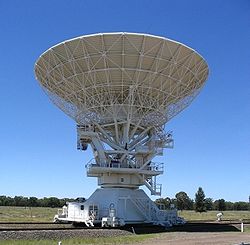 |
Australia Telescope Compact Array Australia Telescope Compact Array The Australia Telescope Compact Array is a radio telescope at the Paul Wild Observatory, twenty five kilometres west of the town of Narrabri in Australia.... (ATCA) |
1991 | 1997 | Ground | 8.7 | HEMT | |||
| Background Emission Anisotropy Scanning Telescope (BEAST) | 2000 | — | Balloon, Ground | 25-35; 38-45 | HEMT | A ground single dish CMB observatory at the University of California's White Mountain Peak Research station. | |||
| Background Imaging of Cosmic Extragalactic Polarization (BICEP) | 2006 | 2008 | Ground | South Pole South Pole The South Pole, also known as the Geographic South Pole or Terrestrial South Pole, is one of the two points where the Earth's axis of rotation intersects its surface. It is the southernmost point on the surface of the Earth and lies on the opposite side of the Earth from the North Pole... |
100, 150 | Bolometer | Will measure large scale polarization with improved precision. | ||
| Balloon-borne Anisotropy Measurement (BAM) | 1995 | 1998 | Balloon | UBC Balloon Expt | 110-250 | Spectrometer | Used differential Fourier Transform Spectrometer to measure degree scale anisotropy | ||
| Balloon-borne Radiometers for Sky Polarisation Observations (BaR-SPoRT) | Future | — | Balloon | 32, 90 | Polarizer / OMT | ||||
| Berkeley-Illinois-Maryland Association Berkeley-Illinois-Maryland Association The Berkeley-Illinois-Maryland Association was a collaboration of the Universities of California, Illinois, and Maryland that built and operated the eponymously named BIMA radio telescope array. Originally the premier imaging instrument in the world at millimeter wavelengths, the array was... (BIMA Bima Bima is a city on the eastern coast of the island Sumbawa in central Indonesia's province West Nusa Tenggara, and the largest city on the island. In 2010 the municipality counted some 142,443 people, separate from the adjoining Regency of Bima with 407,636 population... ) |
1986 | 2004 | Ground | 70-116; 210-270 | SIS | ||||
 |
BOOMERanG experiment BOOMERanG experiment The BOOMERanG experiment measured the cosmic microwave background radiation of a part of the sky during three sub-orbital balloon flights. It was the first experiment to make large, high fidelity images of the CMB temperature anisotropies... |
1997 | 2003 | Balloon | Long-duration balloon above Antarctica | 90-420 | Bolometer | Measured intermediate scale fluctuations with improved precision. | |
| B-mode RAdiation INterferometer Brain The brain is the center of the nervous system in all vertebrate and most invertebrate animals—only a few primitive invertebrates such as sponges, jellyfish, sea squirts and starfishes do not have one. It is located in the head, usually close to primary sensory apparatus such as vision, hearing,... (BRAIN) |
Never | — | Ground | Dome-C, Antarctica | |||||
| Clover Clover (telescope) Clover would have been an experiment to measure the polarization of the Cosmic Microwave Background. It was approved for funding in late 2004, with the aim of having the full telescope operational by 2009... |
Never | — | Ground | 97, 150, 230 | Bolometer | Will measure the small scale fluctuations with improved precision, and the B-mode polarization. | |||
| Cobra | 1982 | 1990 | Sounding Rocket | University of British Columbia | 15-800 | Bolometers/ FTS | Measured spectrum of CMB | ||
| Cosmic Anisotropy Polarization Mapper Cosmic Anisotropy Polarization Mapper CAPMAP is an experiment at Princeton university to measure the polarization of the Cosmic microwave background.-External links:*... (CAPMAP) |
2002 | — | Ground | 40, 90 | MMIC/HEMT | ||||
| Cosmic Anisotropy Telescope Cosmic Anisotropy Telescope The Cosmic Anisotropy Telescope CAT was a three-element interferometer for cosmic microwave background radiation observations at 13 to 17 GHz, based at the Mullard Radio Astronomy Observatory. In 1995, it was the first instrument to measure small-scale structure in the cosmic microwave background... (CAT) |
1994 | 1997 | Ground | Mullard Radio Astronomy Observatory Mullard Radio Astronomy Observatory Mullard Radio Astronomy Observatory is home to a number of large aperture synthesis radio telescopes, including the One-Mile Telescope, 5-km Ryle Telescope, and the Arcminute Microkelvin Imager... |
13-17 | Interferometer / HEMT | Measured the very small scale fluctuations in small regions of the sky. | ||
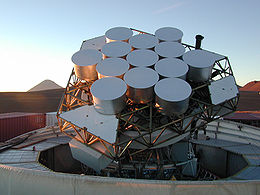 |
Cosmic Background Imager Cosmic Background Imager The Cosmic Background Imager was a 13-element interferometer perched at an elevation of 5,080 metres at Llano de Chajnantor Observatory in the Chilean Andes... (CBI) |
2002 | 2008 | Ground | Llano de Chajnantor Observatory Llano de Chajnantor Observatory Llano de Chajnantor Observatory is an astronomical observatory located at an altitude of 5,104 m in the Chilean Atacama desert, 50 kilometers to the east of San Pedro de Atacama. It is a very dry site - inhospitable to humans - but an excellent site for submillimetre astronomy... , Chile |
26-36 | HEMT | Measured the very small scale fluctuations with improved precision in small regions of the sky and polarization of CMB. | |
| COSMOSOMAS COSMOSOMAS COSMOSOMAS is a circular scanning astronomical microwave experiment to investigate the Cosmic Microwave Background anisotropy and diffuse emission from the Galaxy on angular scales from 1 to 5 degrees. It was designed and built by the Instituto de Astrofísica de Canarias in Tenerife, Spain, in 1998... |
1998 | — | Ground | Teide Observatory Teide Observatory The Observatorio del Teide is an astronomical observatory on Tenerife operated by the Instituto de Astrofísica de Canarias. Opened in 1964, it became one of the first major international observatories, attracting telescopes from different countries around the world because of the good astronomical... , Tenerife, Spain |
10-18 | HEMT | Circular scanning experiments for CMB and foregrounds in Tenerife. | ||
 |
Cosmic Background Explorer (COBE) | 1989 | 1993 | Space | Earth orbit | Temperature anisotropies | |||
| Cosmological Gene | 1999 | — | Ground | 0.6 to 32 | HEMT | ||||
| Degree Angular Scale Interferometer Degree Angular Scale Interferometer The Degree Angular Scale Interferometer was a telescope located in Antarctica. It was a 13-element interferometer operating between 26 and 36 GHz in ten bands. The instrument is similar in design to the Cosmic Background Imager and the Very Small Array... (DASI) |
1999 | 2003 | Ground | 26-36 | HEMT | A temperature and polarization telescope at the South Pole. | |||
| The E and B Experiment The E and B Experiment The E and B Experiment will measure the cosmic microwave background radiation of a part of the sky during two sub-orbital balloon flights. It is an experiment to make large, high-fidelity images of the CMB polarization anisotropies... (EBEX) |
Future | — | Balloon | Antarctica | 150-450 | Bolometer | Detection of the inflationary gravitational-wave background (IGB) signal is a primary goal of the EBEX experiment | ||
| Far Infra-Red Survey (FIRS) | 1989 | 1989 | Balloon | 170-680 | Bolometer | ||||
| KU-band Polarization IDentifier (KUPID) | 2003 | — | Ground | 12-18 | HEMT | ||||
| Medium Scale Anisotropy Measurement (MSAM) | 1992 | 1997 | Balloon | 150-650 | Bolometer | ||||
 |
Millimeter Anisotropy eXperiment IMaging Array Millimeter Anisotropy eXperiment IMaging Array The Millimeter Anisotropy eXperiment IMaging Array experiment was a balloon-borne experiment funded by the U.S. NSF, NASA and Department of Energy, and operated by an international collaboration headed by the University of California, to measure the fluctuations of the cosmic microwave background.... (MAXIMA) |
1995, 1998, 1999 | 1999 | Balloon | Near Palestine, Texas | 150-420 | Bolometer | Measured intermediate scale fluctuations with improved precision. | |
| Millimeter Interferometer (MINT) | Future | — | Ground | 150 | SIS | ||||
| Millimeter-Wave Bolometric Interferometer (MBI-B) | Future | — | Ground | 90 | Bolometer | ||||
| Mobile Anisotropy Telescope Mobile Anisotropy Telescope MAT is an experiment to measure the anisotropy of the Cosmic microwave background at angular scales of 50 MAT is an experiment to measure the anisotropy of the Cosmic microwave background at angular scales of 50... (MAT) |
1997, 1998 | 1998 | Ground | 30-140 | HEMT / SIS | ||||
 |
Planck | 2009 | — | Space | Lagrange 2 | 30-857 | HEMT / Bolometer | Polarization; Temperature anisotropies; Foregrounds | |
| Polarization Observations of Large Angular Regions (POLAR) | 2000 | 2000 | Ground | 26-46 | HEMT | ||||
| Polarization of Background Microwave Radiation (POLARBeaR) | 2011 | — | Ground | Chajnantor plateau (Chile) | 150 - 220 | Antenna-coupled TES | CMB Polarization. Primordial and lensed B-modes. | ||
| Polatron | Never | — | Ground | 100 | Bolometer | ||||
| Princeton I, Q, and U Experiment (PIQUE) | 2002 | 2002 | Balloon | 90 | Bolometer | ||||
| Python | 1992 | 1997 | Ground | 30-90 | HEMT / Bolometer | ||||
| QMAP QMAP QMAP is a balloon experiment to measure the anisotropy of the Cosmic microwave background. It flew twice in 1996, and was used with an interlocking scan of the skies to produce cosmic microwave background maps.... |
1996 | 1996 | Ground | 30-140 | HEMT / SIS | ||||
 |
QUaD QUaD QUaD, an acronym for QUEST at DASI, is a ground based cosmic microwave backrground polarization experiment located at the South Pole... |
2005 | 2007 | Ground | South Pole South Pole The South Pole, also known as the Geographic South Pole or Terrestrial South Pole, is one of the two points where the Earth's axis of rotation intersects its surface. It is the southernmost point on the surface of the Earth and lies on the opposite side of the Earth from the North Pole... |
100, 150 | Bolometer | Measured intermediate scale polarization with improved precision. | |
| Qubic Qubic experiment Qubic is a ground-based project of observational cosmology dedicated to measuring the Cosmic microwave background polarization anisotropies. Qubic is an international collaboration between France, Italy, U.K. and U.S.A., that results from the merging of the BRAIN and MBI collaborations... |
Future | — | Ground | 97, 150, 230 | Bolometer | Will measure the B-mode polarization on intermediate scale. | |||
| Q/U Imaging ExperimenT QUIET QUIET is an astronomy experiment to study the polarization of the cosmic microwave background radiation. QUIET stands for Q/U Imaging ExperimenT. The Q/U in the name refers to the ability of the telescope to measure the Q and U Stokes parameters simultaneously... (QUIET) |
2008 | — | Ground | Llano de Chajnantor Observatory Llano de Chajnantor Observatory Llano de Chajnantor Observatory is an astronomical observatory located at an altitude of 5,104 m in the Chilean Atacama desert, 50 kilometers to the east of San Pedro de Atacama. It is a very dry site - inhospitable to humans - but an excellent site for submillimetre astronomy... , Chile |
40, 90 | HEMT | |||
| RELIKT-1 RELIKT-1 RELIKT-1 - a Soviet cosmic microwave background anisotropy experiment on board the Prognoz 9 satellite gave upper limits on the large-scale anisotropy. A reanalysis of the data in the later years claimed a confident blackbody form and anisotropy of the cosmic microwave background radiation... |
1983 | 1984 | Space | Earth orbit | Temperature anisotropies | ||||
| Saskatoon experiment Saskatoon experiment Saskatoon was an experiment to measure the anisotropy of the cosmic microwave background at angular scales of 60 Saskatoon was an experiment to measure the anisotropy of the cosmic microwave background at angular scales of 60 Saskatoon was an experiment to measure the anisotropy of the cosmic... |
1993 | 1995 | Ground | Saskatchewan Saskatchewan Saskatchewan is a prairie province in Canada, which has an area of . Saskatchewan is bordered on the west by Alberta, on the north by the Northwest Territories, on the east by Manitoba, and on the south by the U.S. states of Montana and North Dakota.... |
26-46 | HEMT | |||
| Sky Polarization Observatory Sky Polarization Observatory The Sky Polarization Observatory was an Italian instrument planned for launch to the International Space Station in for a planned 2 year mission beginning in 2007. There it would observe 80% of the sky for the Cosmic microwave background radiation in the frequency range from 20–100 GHz... (SPOrt) |
Future | — | Space | International Space Station International Space Station The International Space Station is a habitable, artificial satellite in low Earth orbit. The ISS follows the Salyut, Almaz, Cosmos, Skylab, and Mir space stations, as the 11th space station launched, not including the Genesis I and II prototypes... |
Polarization | ||||
.jpg) |
South Pole Telescope South Pole Telescope The South Pole Telescope is a 10 metre diameter telescope located at the Amundsen-Scott South Pole Station, Antarctica. It is a microwave/millimetre-wave telescope that observes in a frequency range between 70 and 300 GHz... |
2006 | Ground | South Pole South Pole The South Pole, also known as the Geographic South Pole or Terrestrial South Pole, is one of the two points where the Earth's axis of rotation intersects its surface. It is the southernmost point on the surface of the Earth and lies on the opposite side of the Earth from the North Pole... |
Will measure the small scale fluctuations and polarization. | ||||
| SPIDER Spider CMB Spider is a balloon-borne experiment designed to search for primordial gravity waves imprinted on the cosmic microwave background . Measuring the strength of this signal puts limits on inflationary theory.... |
2011 | Balloon | 90, 150, 220 | Bolometer | Will measure very large scale polarization. | ||||
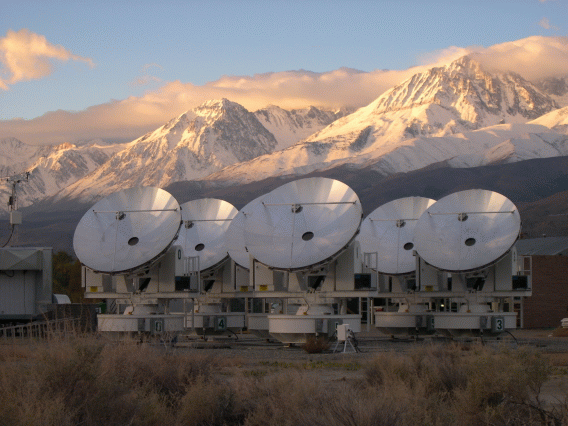 |
Sunyaev-Zeldovich Array (SZA) | Future | — | Ground | 26-36; 85-115 | Interferometer | SZ effect | ||
| Sunyaev-Zeldovich Infrared Experiment (SuZIE) | 1996 | — | Ground | 150, 220, 350 | Bolometer | SZ effect | |||
| Tenerife Experiment Tenerife Experiment The Tenerife Experiment was a Cosmic Microwave Background experiment built by Jodrell Bank of the University of Manchester and in collaboration with the Instituto de Astrofisica de Canarias . It was installed and run at the Observatorio del Teide in Tenerife in 1984 and ran with various upgrades... |
1984 | 2000 | Ground | Tenerife Tenerife Tenerife is the largest and most populous island of the seven Canary Islands, it is also the most populated island of Spain, with a land area of 2,034.38 km² and 906,854 inhabitants, 43% of the total population of the Canary Islands. About five million tourists visit Tenerife each year, the... |
10, 15, 33 | HEMT | |||
| TopHat TopHat (Balloon) TopHat was a scientific experiment launched from McMurdo Station in January 2001 to measure the cosmic radiation produced 300,000 years after the Big Bang. The balloon was launched on January 2, 2001 and proceeded to fly for 644 hours over the continent of Antarctica before landing on January 31,... |
2002 | — | Balloon | 150-720 | Bolometer | ||||
| Very Small Array Very Small Array The Very Small Array is a 14-element interferometric radio telescope operating between 26 and 36 GHz that is used to study the cosmic microwave background radiation. It is a collaboration between the University of Cambridge, University of Manchester and the Instituto de Astrofisica de Canarias... |
2002 | 2008 | Ground | 26-36 | Interferometer / HEMT | Measured intermediate and small scale fluctuations with improved precision in small regions of the sky. | |||
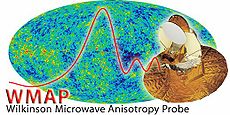 |
Wilkinson Microwave Anisotropy Probe Wilkinson Microwave Anisotropy Probe The Wilkinson Microwave Anisotropy Probe — also known as the Microwave Anisotropy Probe , and Explorer 80 — is a spacecraft which measures differences in the temperature of the Big Bang's remnant radiant heat — the Cosmic Microwave Background Radiation — across the full sky. Headed by Professor... (WMAP) |
2001 | — | Space | Lagrange 2 | 23-94 | HEMT | Temperature anisotropies; Polarization |

